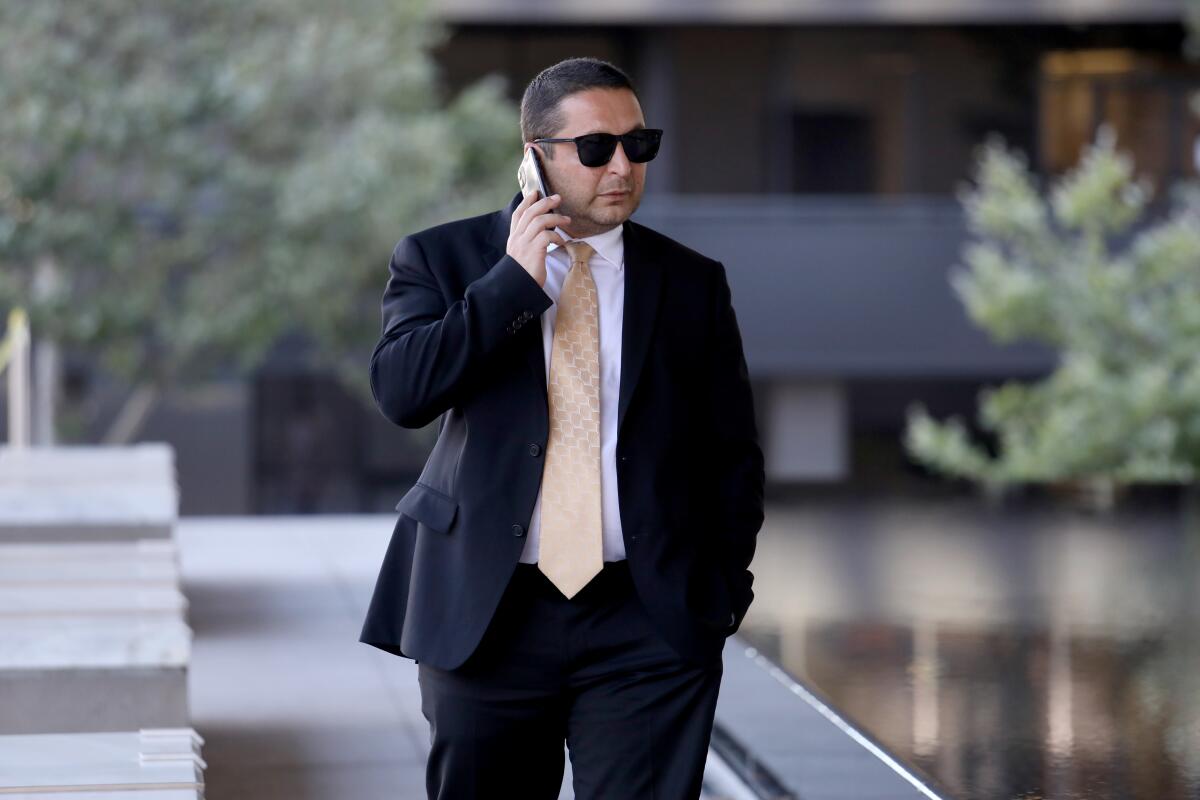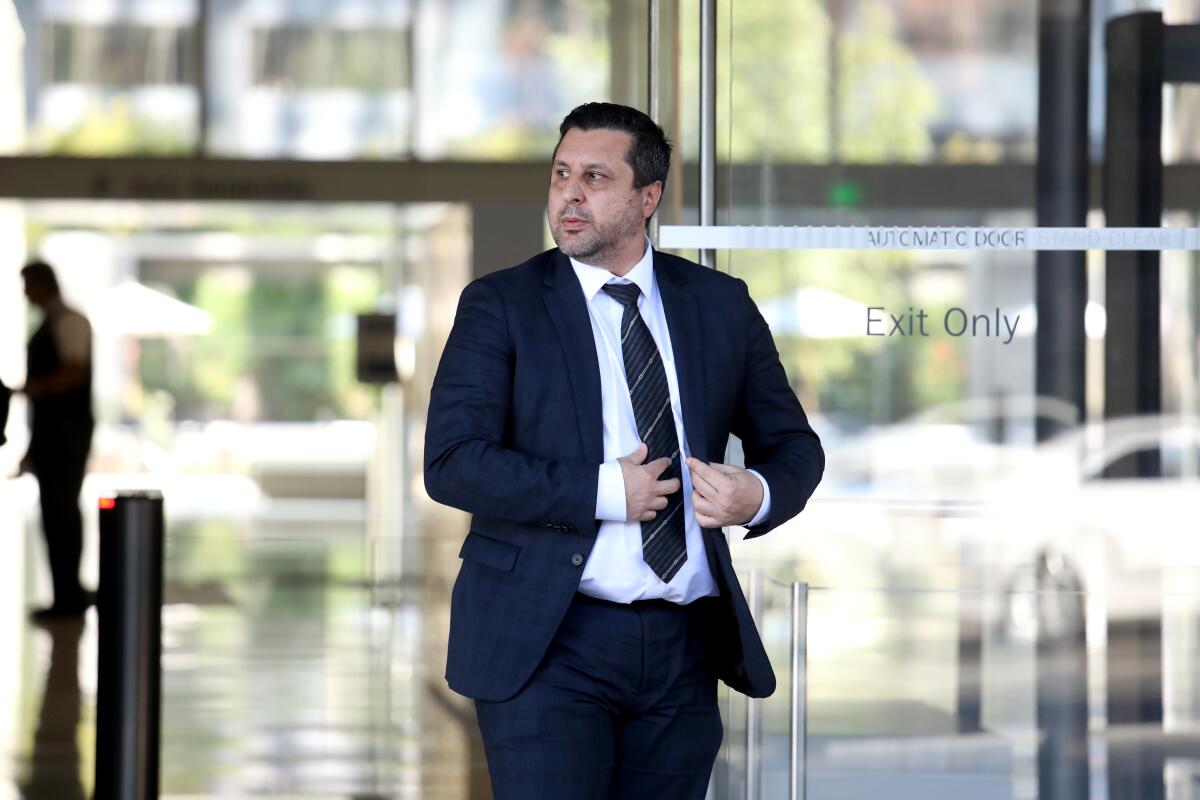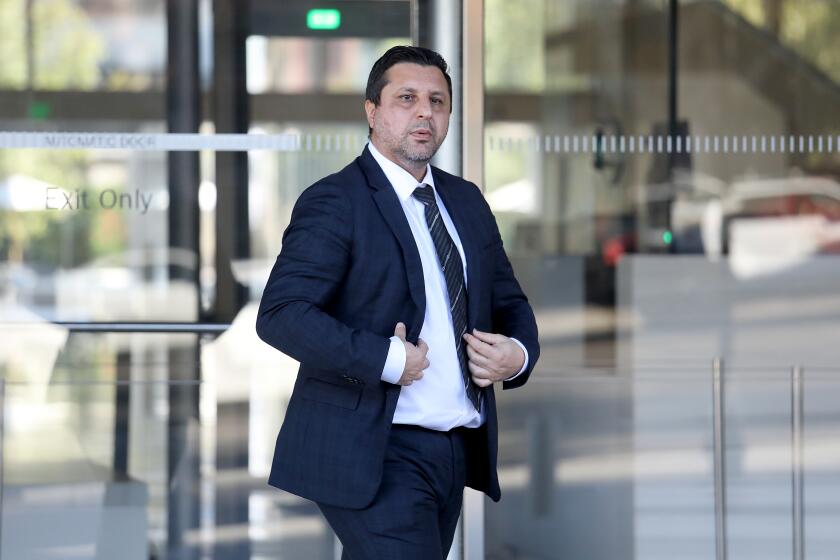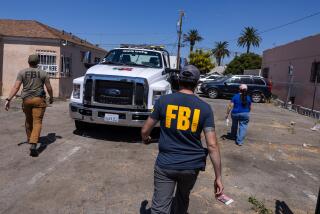Hunt for third fugitive in COVID relief scam follows warnings she would flee

- Share via
Prosecutors had no faith that Tamara Dadyan could be trusted to turn herself in.
Moments after the brash Encino real estate broker was sentenced to 10 years and 10 months in prison for her key role in a tawdry pandemic loan scam, prosecutor Christopher Fenton asked a judge to put her in prison immediately. There was a “high, high likelihood,” he said, that Dadyan would flee, just as two relatives had done after their convictions in the same case.
U.S. District Judge Stephen V. Wilson disagreed. “I’m going to give her 30 days to self-surrender,” he said.
Dadyan vanished on Jan. 28, dodging both her federal prison sentence and her upcoming trial on unrelated state mortgage fraud charges.
It was a crushing blow to prosecutors and investigators who uncovered the conspiracy by Dadyan and seven others to use fake companies, phony payrolls, forged tax returns and stolen driver’s licenses to get $18 million in emergency loans meant to rescue small businesses ravaged by the 2020 lockdowns.
The disappearance of Dadyan and the two others highlights the risks that judges take when they give convicted white-collar criminals weeks or months to get their affairs in order before voluntarily reporting to prison — a common practice in federal court.
A San Fernando Valley family was caught creating fake businesses to get pandemic disaster loans, then spending the money on houses, gold and diamonds.
It also underscores the extreme difficulty of capturing fugitives in financial crime cases, especially swindlers like Dadyan who have roots abroad and expertise in false identifications.
Federal law enforcement authorities believe that Dadyan, 40, and the two other fugitives may have fled to Armenia, which has no extradition treaty with the United States.
Dadyan and her brother-in-law, Richard Ayvazyan, the fugitive mastermind of the COVID-19 loan scam, were born in Armenia when it was part of the Soviet Union, immigrated to the United States as children and grew up in the San Fernando Valley.
On the eve of the family’s fraud trial in June, Dadyan pleaded guilty to conspiracy to commit wire and bank fraud, aggravated identity theft, and conspiracy to commit money laundering. As part of her plea deal with prosecutors, she identified Ayvazyan, his wife, Marieta Terabelian, and other family members as co-conspirators.
Ayvazyan and Terabelian disappeared in August after they were convicted of conspiracy to commit bank fraud and other crimes. The couple left a note telling their three teenage children it was “not a goodbye but a brief break from each other.” Wilson later sentenced Ayvazyan in absentia to 17 years in prison, and Terabelian to six years. The FBI has offered a $20,000 reward for information on their whereabouts.
Dadyan’s husband, Artur Ayvazyan, the brother of Richard, was also convicted and was sentenced to five years in prison. As he did for the others, Wilson let Artur Ayvazyan remain free for months. He turned himself in on time, the day before his wife absconded.
In court papers filed a week before Dadyan fled, her attorney, Jerry Kaplan, dismissed warnings that she would run away as “baloney.” He did not respond to requests for comment.

Wilson, a former prosecutor who has been a federal judge since 1985, declined to comment on how he decides whether defendants need to be taken into custody upon conviction or sentencing. He rejected prosecutors’ requests to lock up both Ayvazyan brothers after the trial jury convicted them in June.
Federal judges generally must weigh whether defendants would pose a flight risk or a danger to the community if they are free on bail before a guilty plea or a trial jury’s verdict. Once someone is convicted, the calculation can change, depending partly on what crimes were committed.
At Dadyan’s Dec. 6 sentencing, Wilson found there was no “clear and convincing evidence” that she would flee or threaten public safety before her surrender date.
Fenton, a Justice Department trial lawyer dispatched from Washington to Los Angeles to join the prosecution team, urged Wilson to keep in mind that Dadyan had “lied to the court repeatedly,” failed to cooperate with probation agents and was part of a “family enterprise” of fraud. He also mentioned the disappearance of Richard Ayvazyan and Terabelian, saying Dadyan might join them overseas and had “every incentive to flee.”

“I don’t think that I can attribute what they did to her,” Wilson said. “I mean that doesn’t seem fair.”
Philip Gutierrez, the chief U.S. district judge for the Central District of California, said many factors can influence a judge’s decision to let a convicted felon voluntarily report to prison.
The Bureau of Prisons needs time to figure out where a new inmate should be housed, he said, and a judge’s concerns about flight risk can taper when a defendant has established a record of complying with conditions of release over a period of months.
“It’s a balancing act, and I can’t say necessarily there’s a right answer or a wrong answer,” he said.
Dadyan was not required to wear an ankle bracelet to track her whereabouts, but was ordered to use a facial recognition app on her phone to check in periodically with the court. Until Jan. 28, she responded as required when she was pinged, said Jeffrey S. Thomason, the court’s acting chief Probation and Pretrial Services officer for the Central District of California.
Nationwide, 811 defendants in federal cases became fugitives last year while Probation and Pretrial Services was monitoring their compliance with bail conditions, including 49 in California’s Central District, Thomason said.
The hunt for Dadyan, Richard Ayvazyan and Terabelian will not be easy. Scott Garriola, a retired FBI agent and veteran fugitive chaser, said the FBI squad that is dedicated to capturing criminals on the run is too small to devote much time to catching nonviolent felons.
“We couldn’t justify spending resources chasing white-collar-crime cases when there were murderers to catch, and rapists and carjackers — those were our marching orders,” said Garriola, best known for his arrest of fugitive Boston gangster James “Whitey” Bulger.
If Dadyan and her in-laws made it to Armenia, presumably by driving first to Mexico to evade arrest at any U.S. airport, they would be hard to extract, particularly if they are living under false identities. Wilson expressed concern in November that the three children of Ayvazyan and Terabelian had sought passports to travel to Armenia, but did not stop them from getting them.
Following the teens’ trail to their parents and aunt in Armenia, if they are there, would require cooperation of local law enforcement, and extraditions of American criminals from there are rare. The FBI’s nearest outpost is on the opposite side of the Lesser Caucasus Mountains in Tbilisi, Georgia.
More to Read
Sign up for Essential California
The most important California stories and recommendations in your inbox every morning.
You may occasionally receive promotional content from the Los Angeles Times.












